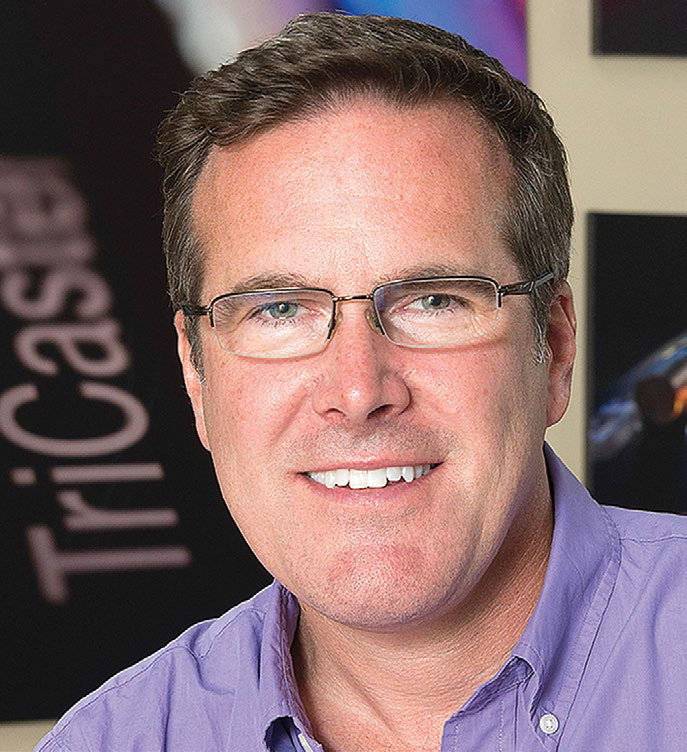2019 NAB Show Preview: IP, Cloud Services Speed Toward the Future
Like every other business sector based upon technology, the television industry has been spinning with innovation and change in the past 20 years. New technologies sparked new standards and new ways of doing things—who would have ever thought 20 years ago that a creditable live video news report could be done with a cellphone?

This is the world we are in today, and it’s interesting to see where some in the industry think we might be headed.
“Growth in broadcast at both the network and local levels has been driven by industry consolidation as much as innovations in resolution and dynamic range,” said Tom Burns, CTO for media & entertainment at cloud-services provider Dell EMC. “Newly amalgamated station groups are now looking to implement agile workflows across multiple markets, and have turned to virtualized infrastructure, software-defined networks and API-driven enterprise IT architectures to compete with web-scale entertainment services.”
WORKFLOW ORCHESTRATION
Burns described how some broadcasters today are taking advantage of the latest tech, cherry-picking the tools to produce different types of content.
“Studios, post-production facilities and broadcasters have realized the advantage of deploying multiple infrastructure tiers,” he said, “from the fully-capitalized on-premise infrastructure that’s in use facility-wide, to the project-oriented gear that may be deployed by an individual production. Workflow orchestration using API management tools is the newest, most exciting method for engineering and operations staff to increase their agility in this hybrid on-premise/cloud environment.”
Therefore, one trend may be that broadcasters and video producers are buying less gear outright, using cloud services to store, process, distribute and share content. Although the phrase “buying less gear outright” sounds ominous to vendors, it doesn’t mean that sales of gear are dropping.

“Like many industries, film and broadcasting is seeing a fair amount of consolidation to achieve various operational efficiencies and maximize productivity,” said Jason Coari, director of high-performance storage solutions at cloud-services provider Quantum. “The industry is not struggling—people are consuming content at a greater rate than ever before—so consolidation is more a response to the need to align resources to this new paradigm shift. As part of this transformation, technology and IT play parallel roles as both enabler and benefactor. From the perspective of enabling organizations wishing to consolidate, the capability of having more services provided by cloud resources allows organizations to easily remove themselves from locally-based resources.”
Technology lets broadcasters and content providers work smarter and more efficiently. One of the advantages of cloud services for video is that it can leverage artificial intelligence to deliver information and perform actions that were in the realm of science fiction just a few years ago.
“Artificial intelligence, for example, is a technology that natively works best in the cloud, because to run efficiently it requires significant computational power and massive amounts of initial raw data that few organizations can generate,” Coari said. “AI has the potential to seriously add value to the archives of film and broadcast by enhancing the metadata of their massive library’s digital assets automatically, with cognitive engines running face and object detection, as well as natural language processing.”
As AI fires up, broadcasters may see lots of interesting data from its cloud archives, giving them ideas on how to reuse and repackage existing footage to provide more online and broadcast content. AI may be the doorway to a new universe of video project workflow. At least one enterprising cloud vendor uses AI to automatically create and edit content based on well-defined editing parameters. All you need to do is shoot a story in the field, upload to the cloud and have it automatically produce a 45-second on-air story and a three-minute web story from the same footage. Imagine what could be done for both news and entertainment videos as AI gains more I.
IP VIDEO GROWS
Using IP to transport video has been gaining momentum in the broadcast industry, particularly now that SMPTE ST 2110 is in the standards toolbox. Although broadcasters have had their own digital standard for decades (SDI), IP video is the digital distribution standard that the rest of the world uses, and its acceptance swamps that of SDI.
IP video—once all the bugs are worked out—holds great promise for being an inexpensive and highly reliable way to route and distribute signals. An additional advantage is that there are a couple orders of magnitude larger educated workforce that understands IP networks than there is for the typical distribution standards used in the television industry.

“Although we have had IP inputs on our switcher for some time, recently more of our customers are asking for IP video inputs,” said Ben Taylor, chief technology officer for production-switcher manufacturer Broadcast Pix. “Sometimes it eases cabling and installation, or it allows sources to be used that would be too remote for standard SDI, HDMI or analog input. Many newer cameras provide IP video output, power-over-IP and IP control for single-wire connection to the camera. Customers also want to be prepared for the future, and they hear IP is going to be significant. Plus, with IP video, our BPfusion real-time graphics can be run on a separate workstation to better support a production team.”
Taylor said that more is on the way.
“When it comes to IP, you can expect more in the future—more IP inputs and enhanced connection to IP sources on Broadcast Pix (and other companies’) switchers, more streaming services and more transcoding and distribution options with expanded format support (1080p/60, UHD/4K),” he said.
Combining IP video with cloud services amplifies the features that can be offered by seemingly familiar video devices. For example, Broadcast Pix’s BPnet distribution network lets users combine local and remote resources in a live broadcast, using cloud-sourced material as if it was right in the studio. And there’s more.
“All BPswitch systems have the ability to switch a production from anywhere in the world over the internet through a standard web browser—something that was not possible five years ago,” Taylor said. “BPnet also offers easy publishing and live streaming to a variety of content distributors, including Facebook, You-Tube, IBM Cloud and others.”
IP video is not just the near future of television—it is here today. Some companies recognized early on that IP video was a game changer and created their own networking standards, including Broadcast Pix (BPnet) and NewTek (NDI). With the adoption of ST 2110, these companies make interfaces that adapt their products to ST 2110 protocols, but their early start at IP video makes BPnet and NDI stable and broadcaster-friendly.

“At this point, we are seeing broadcast and cable networks implementing IP cores,” said Brian Olson, vice president of product management for broadcast equipment manufacturer NewTek in San Antonio. “Those are either new SMPTE ST 2110 infrastructures or conversion of existing ASPEN and SMPTE ST 2022-6 products into ST 2110. There is also some parallel IP movement within the O&O stations and the beginnings of IP adoption inside the large station groups.”
As Olson sees it, the cost and flexibility of IP video are two big factors in what looks like a rapid adoption of the technology.
“The cost and complexity of ST 2110 implementation has created interest in NDI by both the networks and station groups for use in remote facilities, digital production and confidence monitoring of video signals from virtualized software, such as editing systems,” Olson said. “The ability to easily convert between NDI, SDI and ST 2110 makes it possible to have hybrid video workflows, which is the reality for most broadcasters today. IP video production is growing slowly, but the good news is that the paralysis of recent years is now over. Broadcasters are moving forward with their plans and building for the future.”
MASTER CONTROL
In the master control room, consolidation and viewer demand for more content have changed the way television is delivered. With the embrace of digital TV, every OTA broadcaster has a primary channel and one or more secondary channels, all of which need to pass through a master control. (And ATSC 3.0 promises still more secondary channels.)
Then consider station groups that have combined master control operations for a dozen or more stations in regional and even national networks. As distribution morphs to an over-the-top model, who knows exactly how all those program streams will be monitored.
“The need to meet a growing consumer appetite for more content has only become more pronounced in recent years,” said Raed Al Tikriti, vice president for playout at broadcast products manufacturer Grass Valley. “To meet the shifting demands of viewers, channels need to transition to a mix of linear and digital services. The master control room now has to manage delivery to a more diverse range of outlets.”
IP video plays an important role in today’s and future master control facilities, Al Tikriti said.
“Today’s MCRs need to be both flexible and agile enough to handle monitoring and playout across more platforms,” he said. “IP-based infrastructures deliver this flexibility and agility, allowing more channels to be added more cost-effectively. Additionally, with IP-based systems, the need to change playout hardware as formats evolve is eliminated.”
As IP replaces existing SDI infrastructure at broadcasters, Al Tikriti expects cloud and virtualized applications will begin to increasingly filter through to the master control room. There, each channel can be run off a virtualized machine, rather than requiring a dedicated piece of equipment. Rather than being rendered obsolete, the MCR will become much more scalable, Al Tikriti said, making it possible to rapidly add and take down channels, as well as adapt services to respond to market demand.
“Centralizing MCR operations enables media companies to manage and control multiple operations—all networked together—from a single location,” Al Tikriti said. “Centralized diagnostics, commissioning and maintenance deliver cost efficiencies, and this model also reduces the overall cost of personnel and technology investments. As we move towards greater adoption of cloud and virtualized broadcast environments, centralizing master control will be a key part of that transition.”
Despite the move to the cloud and IP routing, master control rooms will still play an important role in the broadcast facility, according to Marc Ravard, marketing product manager for signal processing at equipment manufacturer Ross Video Systems.
“IP is simply about connectivity,” he said. “Technology for station-in-a-box and cloud connectivity will continue to evolve as well, but we believe the market for an edge master-control device will persist. A cost-effective on-premise edge device will allow operators to keep their program on air in the absence of an IP stream, and provides a simple and reliable way to break to live news.”
As the rapid pace of technology change seems to overwhelm us, Ravard recommends keeping your eye on the goal.
“On-premise, off-premise, private cloud or public cloud, SDI or IP, master control is all about releasing a linear channel,” he said. “Of all functions, master control is one that requires attention to detail in its design, as it is the revenue stream for the broadcaster—loss of channel equals loss of revenue. Technology will advance to offer more centralization, more IP, more combined functionality and more automation, but the need for mission-critical reliability offered by a local edge device will persist.”
Years ago, the NAB used the term “convergence” to define the union of traditional television systems with computers, and the Las Vegas Convention Center was festooned with signs that identified the NAB Show as the “Convergence Marketplace,” where the paths of the television world and computer universe crossed. Although such convergence was a little early for 2000, it is absolutely the state of the NAB Show today.
“I think convergence is in full swing today,” NewTek’s Olson said. “Most young people don’t view video content on televisions anymore—they use their computers and mobile devices. Smartphones have better cameras than most broadcast cameras did just a few years ago. And, with Skype, Facetime, Google Hangouts and other video chat platforms, it’s possible to do a ‘live shot’ from almost anywhere by anyone.
“NewTek has been producing video on computers for more than 30 years now, so this seems very natural to us,” Olson added. “The key to making it all work is IP video.”
Get the TV Tech Newsletter
The professional video industry's #1 source for news, trends and product and tech information. Sign up below.
Bob Kovacs is the former Technology Editor for TV Tech and editor of Government Video. He is a long-time video engineer and writer, who now works as a video producer for a government agency. In 2020, Kovacs won several awards as the editor and co-producer of the short film "Rendezvous."

